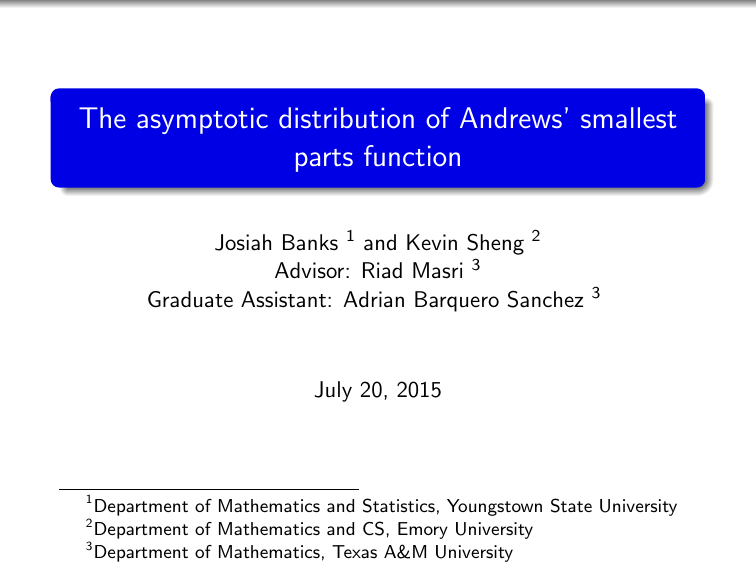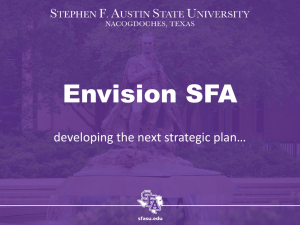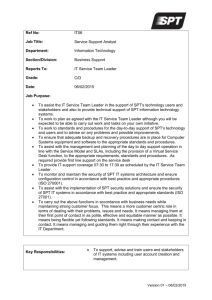The asymptotic distribution of Andrews’ smallest parts function
advertisement

The asymptotic distribution of Andrews’ smallest
parts function
Josiah Banks 1 and Kevin Sheng 2
Advisor: Riad Masri 3
Graduate Assistant: Adrian Barquero Sanchez
3
July 20, 2015
1
Department of Mathematics and Statistics, Youngstown State University
Department of Mathematics and CS, Emory University
3
Department of Mathematics, Texas A&M University
2
Integer partitions
Examples:
4=3+1=2+2=2+1+1=1+1+1+1
5=4+1=3+2=3+1+1=2+2+1=2+1+1+1=1+1+1+1+1
Integer partitions
Let n be a positive integer.
Definition
A partition λ of n is a non-increasing sequence of positive integers
λ1 ≥ λ2 ≥ . . . ≥ λk ≥ 1 such that ∑ki=1 λi = n. We denote this
partition by λ = (λ1 , λ2 , . . . , λk ) and call λi the parts of λ, where
1 ≤ i ≤ k.
Definition
We call p(n) = ∣{partitions λ of n}∣ the partition function.
Congruences for p(n)
The well-known Ramanujan congruences for p(n) are:
p(5n + 4) ≡ 0 (mod 5)
p(7n + 5) ≡ 0
p(11n + 6) ≡ 0
(mod 7)
(mod 11).
Andrews’ smallest parts function
Definition (Andrews)
spt(n) = ∑ #(smallest parts of λ)
λ
Example:
Partitions of 4 = {(4), (3, 1), (2, 2), (2, 1, 1), (1, 1, 1, 1)}
spt(4) = 1 + 1 + 2 + 2 + 4 = 10
Congruences for spt(n)
Andrews’ congruences for spt(n):
spt(5n + 4) ≡ 0
(mod 5)
spt(7n + 5) ≡ 0
(mod 7)
spt(13n + 6) ≡ 0
(mod 13).
Central question under study
Theorem (Hardy and Ramanujan)
1
p(n) ∼ √ e π
4n 3
√
2n
3
Question: Does there exist a similar asymptotic formula for
spt(n)? And if so, how can we obtain it?
Central question under study
Theorem (Hardy and Ramanujan)
1
p(n) ∼ √ e π
4n 3
√
2n
3
Question: Does there exist a similar asymptotic formula for
spt(n)? And if so, how can we obtain it?
Answer: Yes! Such an asymptotic formula can be obtained via
methods involving quadratic forms, Heegner points and modular
forms.
The group SL2 (Z)
Definition
SL2 (Z) = {M = (
α β
) ∶ α, β, γ, δ ∈ Z, αδ − βγ = 1} .
γ δ
The complex upper-half plane:
H = {z ∈ C ∶ Im(z) > 0}.
SL2 (Z) acts on H by linear fractional transformations:
M ⋅z =
αz + β
.
γz + δ
Fundamental domain for SL2 (Z)
Figure: Fundamental domain F for SL2 (Z)
Congruence subgroups
Definition
Let N be a positive integer. The congruence subgroup of level N is
Γ0 (N) ∶= {M ∈ SL2 (Z) ∶ γ ≡ 0 mod N} .
Fundamental domain for Γ0 (6)
Figure: Fundamental domain F6 for Γ0 (6)
The hyperbolic measure
Define the Γ0 (N)-invariant measure
dµ(z) ∶=
We have
vol(F) ∶= ∫
F
dxdy
.
y2
dxdy π
=
y2
3
and
vol(FN ) = [SL2 (Z) ∶ Γ0 (N)] ⋅ vol(F)
Binary Quadratic Forms
Definition
A binary quadratic form is a polynomial
Q(x, y ) = ax 2 + bxy + cy 2 ∈ Z[x, y ].
The integer d ∶= b 2 − 4ac is called the discriminant.
Binary quadratic forms
Let
Qd,N ∶= {Q = [a, b, c] ∶ d < 0, a > 0, N ∣ a, (a, b, c) = 1}.
The group Γ0 (N) acts on Qd,N as follows:
Q M (x, y ) = Q(αx + βy , γx + δy ),
Theorem (Gauss)
The quotient Γ0 (N)/Qd,N is finite.
M ∈ Γ0 (N).
Heegner Points
Definition
Let Q ∈ Qd,N . A Heegner point is the root τQ of Q(x, 1) in H,
√
−b + i ∣d∣
τQ ∶=
.
2a
Note: We will only consider Heegner points of forms up to
Γ0 (N)-equivalence.
Additional notation
Let d = −24n + 1 < 0 be square free.
Define
Λn ∶= {τQ ∶ Q ∈ Γ0 (6)/Q−24n+1,6 }
and
On ∶= {τQ ∈ Λn ∶ Q = [a, b, c], b ≡ 1 (mod 12)}.
Theorem (Siegel)
For ε > 0,
1
h(−24n + 1) ∶= ∣On ∣ ≫ε n 2 −ε .
Some pictures
Figure: Points lying in O15 and O400 respectively with discriminant
d = −24n + 1
(a) d = −24n + 1 = −359
(b) d = −24n + 1 = −9, 599
The main theorem
Theorem. (B,B-S,M,S) For n ∈ Z+ with cn ∶= 24n − 1 square-free,
we have
spt(n) = c ⋅ h(−24n + 1) + h(−24n + 1)vol(S2,n ) + ∣S3,n ∩ On ∣
⎡
⎤
⎥
1
1 ⎢⎢
⎥
(1
−
+
e(−τ
)
−
)
e(−τ
)
∑
∑
⎢
⎥
12 ⎢τ ∈Rn ∩On
2π
Im(τ
)
⎥
∗ ∩O
τ
∈R
n
n
⎣
⎦
1
1
−
+ε
+ Oε (n 2 2868 ),
where c ≠ 0 and e(z) ∶= e 2πiz .
The main theorem
Im(z) =
√
cn
12
Im(z) =
cn
Im(z) =
24
π
+ cn 240
Im(z) =
24
π
+ cn 176
S3,n
28/239
12
Rn
Rn∗
S2,n
S1,n
-0.5
-0.25
0
0.25
0.5
−
−
1
1
Previous work
Using different methods, K. Bringmann proved that
spt(n) = MT(n) + Oε (n1+ε ),
where MT(n) is an exponential main term.
K. Bringmann, ”On the explicit construction of higher
deformations of partition statistics”, Duke Mathematical
Journal, (2007).
The error term in our main theorem saves a power of n.
Some key components
An exact formula for spt(n) due to Bruinier-Ono and
Ahlgren-Andersen,
spt(n) =
1
24n − 1
p(n),
∑ g (τ ) −
12 τ ∈On
12
where g (z) is a Γ0 (6)-invariant weakly-holomorphic modular
form.
Asymptotic formulae due to Masri for p(n) and
∑ g (τ ).
τ ∈On
Counting Heegner points
The number ∣Rn ∩ On ∣ appears in the asymptotic formula for
∑ g (τ ).
τ ∈On
The majority of our effort was devoted to counting points in
Rn ∩ On (a problem of independent interest).
Plot of R5000 ∩ O5000
30
20
10
Im(z) =
−0.5
−0.25
0.25
24
π
1
+ (119, 999)− 240
0.5
Figure: Heegner points τ ∈ R5000 ∩ O5000 .
Counting Heegner points
Proposition. Let b > 0, 0 < δ < 1/2 and define
Rn,b,δ ∶= {z ∈ H ∶
24
π
1 −δ
cn2
12
+ cn−b ≤ Im(z) ≤
}.
Assume that
1
L(χ−24n+1 , 12 + it) ≪ε (1 + ∣t∣)B+ε n 4 −δ1 +ε
for some 0 ≤ B < 1 and 0 < δ1 ≤ 1/4. Then we have
∣Rn,b,δ ∩ On ∣ = h(−24n + 1)
1
vol(Rn,b,δ )
+ Oε (n 2 −f (δ,δ1 ,b,B)+ε ).
4π
The rectangle Rn,b,δ
Im(z) =
√
cn
12
1 −δ
Im(z) =
cn2
12
Im(z) =
24
π
Rn,b,δ
-0.5
-0.25
0
0.25
0.5
+ cn−b
Remarks
f is an explicit function which can be made positive for
certain choices of the parameters.
If we assume the Lindelöf hypothesis (B = 0 and δ1 = 1/4), we
can take any δ > 0.
The error term in our main theorem comes from the best
unconditional bound (B = 1/6 and δ1 = 1/12), due to Matt
Young (to appear in JEMS).









